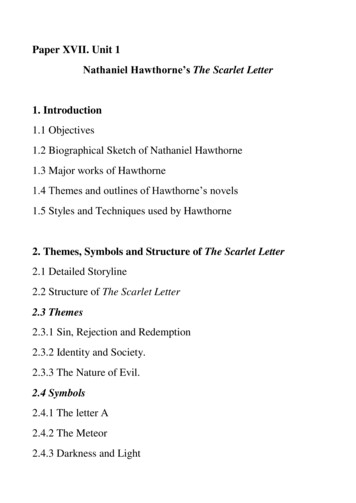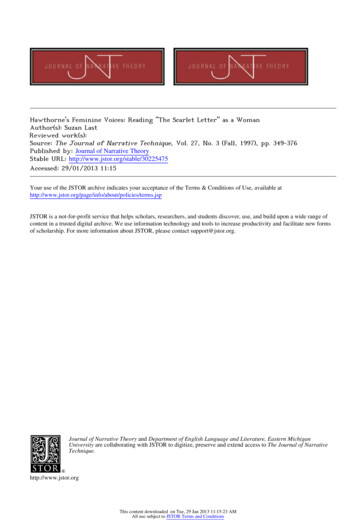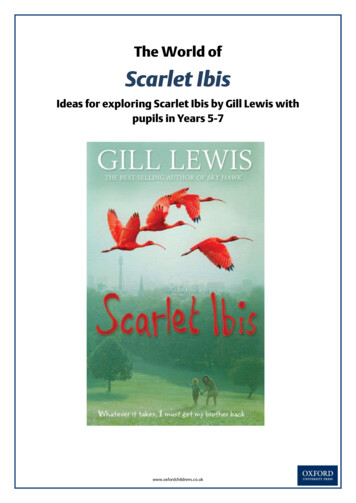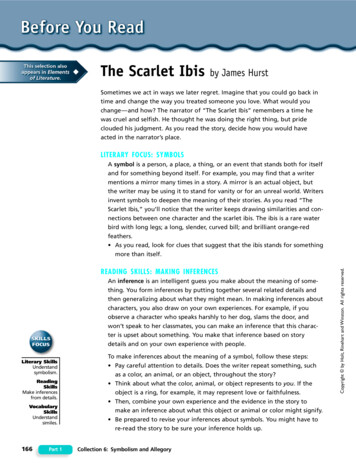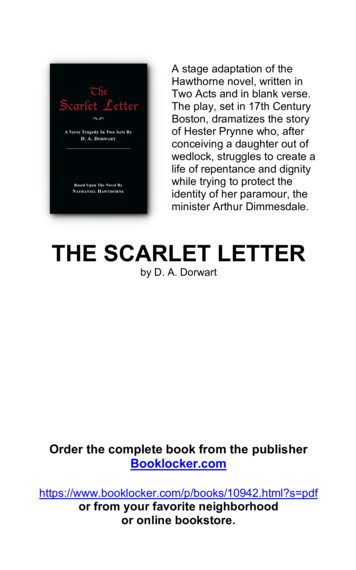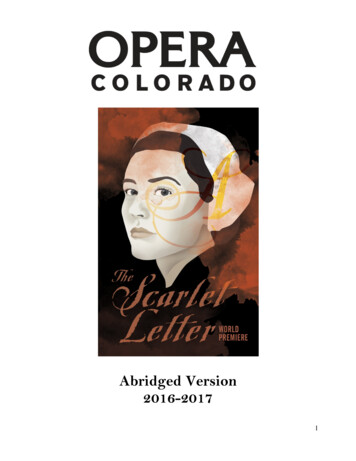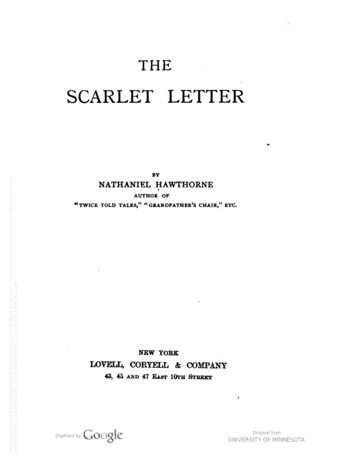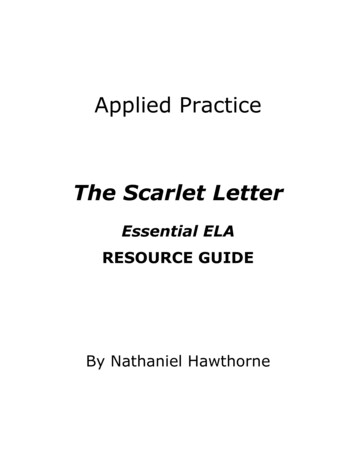
Transcription
Applied PracticeThe Scarlet LetterEssential ELARESOURCE GUIDEBy Nathaniel Hawthorne
Copyright 2020 by Applied PracticeAll rights reserved. No part of the Answer Key and Explanationportion of this publication may be reproduced or transmitted in anyform or by any means, electronic or mechanical, includingphotocopy, recording, or any information storage and retrievalsystem, without permission in writing from the publisher.Only the Student Practices portion of this publication may bereproduced in quantities limited to the size of an individualteacher’s classroom. It is not permissible for multiple teachers toshare a single Resource Guide.Printed in the United States of America.
APPLIED PRACTICEResource GuideThe Scarlett LetterEssential ELATeacher NotesA Note for Teachers .5Teaching ResourcesStrategies for Multiple-Choice Reading Questions .7Strategies for Open-Ended Reading Questions.8Strategies for Essay Questions .9Student PracticesReading Practices .11Visual and Informational Analysis .39Revising and Editing Passages.46Essay Writing Prompts .71Answer Keys and ExplanationsReading Practices .80Visual and Informational Analysis .92Revising and Editing Passages.94 2020 Applied Practice, Dallas, TX. All rights reserved.3
READING PRACTICESPractice 1Read the following passage from Chapter 2 of The Scarlet Letter, “The Market-Place,” andchoose the best answer to each of the following questions.1The grass-plot before the jail, in Prison Lane, on a certain summer morning, not less thantwo centuries ago, was occupied by a pretty large number of the inhabitants of Boston, all withtheir eyes intently fastened on the iron-clamped oaken door. Amongst any other population, orat a later period in the history of New England, the grim rigidity that petrified the beardedphysiognomies of these good people would have augured some awful business in hand. It couldhave betokened nothing short of the anticipated execution of some noted culprit, on whom thesentence of a legal tribunal had but confirmed the verdict of public sentiment. But, in that earlyseverity of the Puritan character, an inference of this kind could not so indubitably be drawn. Itmight be that a sluggish bond-servant, or an undutiful child, whom his parents had given over tothe civil authority, was to be corrected at the whipping-post. It might be, that an Antinomian, aQuaker, or other heterodox religionist was to be scourged out of the town, or an idle and vagrantIndian, whom the white man’s fire-water had made riotous about the streets, was to be drivenwith stripes into the shadow of the forest. It might be, too, that a witch, like old MistressHibbins, the bitter-tempered widow of the magistrate, was to die upon the gallows. In eithercase, there was very much the same solemnity of demeanor on the part of the spectators; asbefitted a people amongst whom religion and law were almost identical, and in whose characterboth were so thoroughly interfused, that the mildest and the severest acts of public disciplinewere alike made venerable and awful. Meagre, indeed, and cold was the sympathy that atransgressor might look for from such by-standers, at the scaffold. On the other hand, a penalty,which, in our days, would infer a degree of mocking infamy and ridicule, might then be investedwith almost as stern a dignity as the punishment of death itself.2It was a circumstance to be noted, on the summer morning when our story begins itscourse, that the women, of whom there were several in the crowd, appeared to take a particularinterest in whatever penal infliction might be expected to ensue. The age had not so muchrefinement, that any sense of impropriety restrained the wearers of petticoats and farthingalefrom stepping forth into the public ways, and wedging their not unsubstantial persons, ifoccasion were, into the throng nearest to the scaffold at an execution. Morally, as well asmaterially, there was a coarser fibre in those wives and maidens of old English birth andbreeding, than in their fair descendants, separated from them by a series of six or sevengenerations; for, throughout that chain of ancestry, every successive mother has transmitted toher child a fainter bloom, a more delicate and briefer beauty, and a slighter physical frame, if not 2020 Applied Practice, Dallas, TX. All rights reserved.11
7. The reader can infer that the narrator’s society differs from Puritan society in all of thefollowing ways EXCEPT that in the narrator’s societyA.B.C.D.a greater distinction is made between minor and major crimeswrongdoers are not subjected to humiliating punishmentswomen in general are more refinedcivil law is less closely tied to religious law8. Which of the following is an opinion of the speaker in paragraph 7?A.B.C.D.Bringing shame on the whole community merits a sentence of death.There is a law in the Scripture to support Hester’s death.There is a law in the statute books to support Hester’s death.The magistrates have given Hester a lighter sentence than death.9. Which line in the passage best foreshadows the treatment that Hester will receive from thetownspeople?A. “. . . the grim rigidity that petrified the bearded physiognomies of these good peoplewould have augured some awful business in hand.”B. “Meagre, indeed, and cold was the sympathy that a transgressor might look for from suchby-standers, at the scaffold.”C. “‘If the hussy stood up for judgment before us five, . . . would she come off with such asentence as the worshipful magistrates have awarded?’”D. “‘. . . let her cover the mark as she will, the pang of it will be always in her heart.’”10. The point-of-view of The Scarlet Letter, as represented by this selection, is —A.B.C.D.first-person, Hester Prynnefirst-person, Reverend Dimmesdalethird-person, limitedthird-person, omniscient11. Read this sentence from the selection.“But she—the naughty baggage—little will she care what theyput upon the bodice of her gown!”The tone of this sentence can best be described ng 2020 Applied Practice, Dallas, TX. All rights reserved.14
12. What hints does the narrator give that might explain the different opinion expressed inparagraph 6? Support your answer with evidence from the text. (extended response)13. What is the narrator’s own attitude toward the Puritans, and specifically toward theassembled crowd, and which of the narrator’s word choices help reveal this attitude?Support your answer with evidence from the text. (short answer) 2020 Applied Practice, Dallas, TX. All rights reserved.15
Questions 8 – 12 refer to the following outline. Read the outline carefully and answer thefollowing questions.Camilla’s OutlineI.II.III.IVEarly lifeA. Born1. On July 4, 18042. In Salem, Massachusetts3. From Puritan ancestorsB. Father1. Salem Custom House2. Died in 18083. Left family in povertyC. Mother1. Highly dependent on relatives for support2. Overly protective of Nathaniela. Caused him to be shyb. Led him to be studiousYoung adulthoodA. Graduated from Bowdoin CollegeB. Devoted to his writing1. Wrote stories and novel Fanshawe2. Worked two local jobsa. Incomeb. Boston Custom Housec. Worked as a sea captainC. Introduced to future wifeMiddle-age lifeA. Married to Sophia Peabody1. Mother and sister ran a school.2. Sophia was a teacher.3. Sophia was an artist.a. Recreated famous artworkb. Illustrated Hawthorne’s The Gentle BoyB. Lived in Concord, Massachusetts1. Neighbors—Emerson and Thoreau2. Hawthorne—friend and skepticC. Succeeded as a writerLater yearsA. Married total of twenty-two yearsB. Fathered three childrenC. Resided in New EnglandD. Stayed four years in EnglandE. Died at fifty-nine 2020 Applied Practice, Dallas, TX. All rights reserved.42
8. Where could the writer add information about the author’s traveling around Europewith his wife and children and about his experiences living abroad?A.B.C.D.As III.B.3. and III.B.4.As IV.D.1. and IV.D.2.As I.B.4. and I.B.5.As I.A.4. and I.A.5.9. Based on the information in the writing plan, which title would be more appropriatefor subtopic I.A.?A.B.C.D.BirthplacePlace of birthBirthFacts of birth10. Camilla wants to add the following details to the outline:Attended with LongfellowAttended with later-to-be-President PierceBased on the organization of the writing plan, where would be the most appropriateplace for this subtopic to be added?A.B.C.D.As III.B.3. and III.B.4.As I.B.4. and I.B.5.As II.A.1. and II.A.2.As II.B.2.d. and II.B.2.e.11. What is the most effective way for Camilla to improve the organization of her writingplan?A.B.C.D.Reverse I.B.1. and II.B.2.c.Move III.A.2. to follow I.C.3.Reverse II. and III.B.1.Move III.B.2 to follow I.A.3.12. Based on information in Camilla’s outline, which of the following organizationalpatterns would be most appropriate for her essay?A.B.C.D.Cause and effectChronologicalCompare and contrastAnalysis 2020 Applied Practice, Dallas, TX. All rights reserved.43
SELECTION 3Questions 1 – 10 refer to the following essay written on a group project in English class.Carefully read the essay and look for any revisions that need to be made and answer thequestions that follow.Group Three: Archetypes(1) Our group was assigned the task of finding out the meaning of the term “archetype”and then discussing any examples of archetypes we could find in The Scarlet Letter. (2) We werenot familiar with the term, so we went to the library and also did some online research. (3) Mostof our research pointed toward the twentieth-century Swiss psychologist, Carl Jung. (4) Jungbelieved that all people share what he called a “collective unconscious” and that there are somesymbols, called “archetypes,” that are universal. (5) For example, Jung would say that all people,regardless of when or where they live, recognize darkness as a negative symbol. (6) Darknessrepresents danger, the unknown, or even evil. (7) As it happens, people recognize light as asymbol for safety, goodness, and wisdom.(8) Literary archetypes are those that occur in many works of literature in many differentcultures. (9) We understood the concept of archetypes more clearly when we began to think offamiliar fairy tales, which are full of such symbols. (10) There is often a hero who must set outinto the dark forest and fight evil before he or she obtains a prized goal. (11) Wicked witches andbeautiful, kind Princesses fill the pages of fairy tales. (12) “Evil” plants, such as the thorn bushesthat grow over Sleeping Beautys’ palace, present a contrast to the beautiful roses presented byprinces to their beloveds.(13) Having a basic understanding of what literary archetypes are, we set out to examineThe Scarlet Letter to see if we could apply our knowledge to this novel. (14) The dark forest iswhere Mistress Hibbins and the devil conduct their meetings. (15) The clear light of day is wherethings are exposed for what they are. (16) We remembered that little Pearl comments that the sundoes not “love” Hester because every time Hester steps into a bright patch of sunlight, a cloudpasses by and covers the light. (17) The symbolic meaning is that Pearl realizes her mother hasdone something that is not quite right or is not correct.(18) Hester herself seems to be a perfect example of the archetype of the Fall; just asAdam and Eve “fell” in the Garden of Eden, Hester has fallen out of grace with her Puritancommunity. (19) Because of this, she comes to represent another archetype: the outcast. (20) Onthe other hand, Hester names her daughter “Pearl,” a name associated with a precious, costlygem. (21) Beautiful jewels are another archetype, and Hester’s choice of this name for herdaughter indicate that Hester has paid a great price for her and that, despite the shame involved,she considers Pearl to be a person of great worth. 2020 Applied Practice, Dallas, TX. All rights reserved.53
(22) Among the many other examples of archetypes we found in the novel, one of themost obvious is the devil figure. (23) Of course, the devil himself is referred to in the novel. (24)Mistress Hibbins tries to entice Hester into the forest. (25) Mistress Hibbins wants Hester to meetwith the devil. (26) She also wants Hester to sign his “black book.” (27) However, RogerChillingworth is the clearest embodiment of evil in the novel. (28) Chillingworth is deformed(another archetype), and as his plan for vengeance proceeds, he becomes more and moremishapen, both physically and spiritually. (29) Chillingworth’s face begins to darken, and thetownspeople begin to sense that he is in contact with the sooty regions inhabited by the devil.(30) When we make our presentation to the class, we will display a chart showing all thearchetypes we discovered in Hawthorne’s novel. (31) Being aware of archetypes has changed theway we look at modern films such as Star Wars and the way we approach classic works ofliterature like The Scarlet Letter. (32) We have concluded that Carl Jung was probably right;many of the symbols and patterns that occur over and over again in literature seem to beuniversal.1. Which of these words or phrases would be a more effective transition insentence 7?A.B.C.D.Likewise,Therefore,Nevertheless,In fact,2. The following detail needs to be added to the third paragraph (sentences 13-17).We quickly realized that light and darkness are important inthe story.Where is the most logical place to insert this sentence?A.B.C.D.At the beginning of the paragraphAfter sentence 14After sentence 16After sentence 13 2020 Applied Practice, Dallas, TX. All rights reserved.54
ESSAY WRITING PROMPTSPersuasive WritingAt the beginning of The Scarlet Letter one of the women in the community declares that Hester“has brought shame upon us all” with her sin.Think carefully about this statement.Write an essay stating your position on whether you believe that the actions of one person reflecton all the people with whom that person associates.Be sure to — state your position clearlyuse appropriate organizationprovide specific support for your argumentchoose your words carefullyedit your writing for grammar, mechanics, and spelling 2020 Applied Practice, Dallas, TX. All rights reserved.71
The Scarlet Letter, as represented by this selection, is — A. first-person, Hester Prynne B. first-person, Reverend Dimmesdale C. third-person, limited D. third-person, omniscient . 11. Read this sentence from the selection. The tone of this sentence can best be described as .


